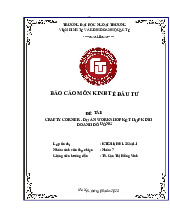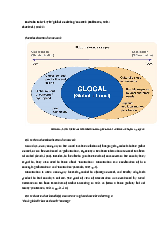














Preview text:
lOMoAR cPSD| 36066900 lOMoAR cPSD| 36066900 Chapter 1:
Marketing: The process by which companies engage customers, build strong customer relationships,
and create customer value in order to capture value from customers in return.
If the marketer engages consumers effectively, understands their needs, develops products that
provide superior customer value, and prices, distributes, and promotes them well, these products will sell easily.
5 core customer and marketplace concepts 1. Needs, wants, and demands;
Needs: States of felt deprivation.
Wants: The form human needs take as they are shaped by culture and individual personality.
Demands: Human wants that are backed by buying power
2. Market offerings (products, services, and experiences);
Market offerings: Some combination of products, services, information, or experiences offered to a
market to satisfy a need or want.
- Marketing myopia: The mistake of paying more attention to the specific products a company
offers than to the benefits and experiences produced by these products 3. Value and satisfaction;
Key in developing and managing customer relationships
4. Exchanges and relationships; and
Exchange: The act of obtaining a desired object from someone by offering something in return. 5. Markets
Market: The set of all actual and potential buyers of a product or service 3 lOMoAR cPSD| 36066900
Marketing management: The art and science of choosing target markets and building profitable relationships with them.
The marketing manager’s aim is to engage, keep, and grow target customers by creating, delivering,
and communicating superior customer value.
To design a winning marketing strategy, the marketing manager must answer two important questions:
1. What customers will we serve (what’s our target market)?
2. How can we serve these customers best (what’s our value proposition)? 5 alternative concepts
Production concept: The idea that consumers will favor products that are available and highly
affordable; therefore, the organization should focus on improving production and distribution efficiency.
Product concept: The idea that consumers will favor products that offer the most quality, performance,
and features; therefore, the organization should devote its energy to making continuous product improvements.
Selling concept: The idea that consumers will not buy enough of the firm’s products unless the firm
undertakes a large-scale selling and promotion effort.
Marketing concept: A philosophy in which achieving organizational goals depends on knowing the
needs and wants of target markets and delivering the desired satisfactions better than competitors do.
Societal marketing concept: The idea that a company’s marketing decisions should consider consumers’
wants, the company’s requirements, consumers’ long-run interests, and society’s long-run interests. 4 lOMoAR cPSD| 36066900
Customer relationship management: The overall process of building and maintaining profitable
customer relationships by delivering superior customer value and satisfaction.
The key to building lasting customer relationships is to create superior customer value and satisfaction.
Customer-perceived value: The customer’s evaluation of the difference between all the benefits and all
the costs of a marketing offers relative to those of competing offers.
- Customer satisfaction: The extent to which a product’s perceived performance matches a buyer’s expectations.
Customer-engagement marketing: Making the brand a meaningful part of consumers’ conversations
and lives by fostering direct and continuous customer involvement in shaping brand conversations, experiences, and community
Consumer-generated marketing: Brand exchanges created by consumers themselves—both invited and
uninvited— by which consumers are playing an increasing role in shaping their own brand experiences and those of other consumers
Partner relationship management: Working closely with partners in other company departments and
outside the company to jointly bring greater value to customers.
Customer lifetime value: The value of the entire stream of purchases a customer makes over a lifetime of patronage
Share of customer: The portion of the customer’s purchasing that a company gets in its product categories.
Customer equity: The total combined customer lifetime values of all of the company’s customers (The
ultimate aim of customer relationship management is to produce high customer equity). 5
PMk-T222WSB-4_Do Phuong Hien_21001444 lOMoAR cPSD| 36066900
Digital and social media marketing: Using digital marketing tools such as websites, social media, mobile
apps and ads, online video, email, and blogs to engage consumers anywhere, at any time, via their digital devices. 6
PMk-T222WSB-4_Do Phuong Hien_21001444 lOMoAR cPSD| 36066900 Chapter 2:
Strategic planning: The process of developing and maintaining a strategic fit between the organization’s
goals and capabilities and its changing marketing opportunities.
Mission statement: A statement of the organization’s purpose—what it wants to accomplish in the larger environment.
Business portfolio: The collection of businesses and products that make up the company.
Portfolio analysis: The process by which management evaluates the products and businesses that make up the company.
Product/market expansion grid: A portfolio-planning tool for identifying company growth opportunities
through market penetration, market development, product development, or diversification. 7
PMk-T222WSB-4_Do Phuong Hien_21001444 lOMoAR cPSD| 36066900
- Market penetration: Company growth by increasing sales of current products to current market
segments without changing the product.
- Market development: Company growth by identifying and developing new market segments for current company products.
- Product development: Company growth by offering modified or new products to current market segments.
- Diversification: Company growth through starting up or acquiring businesses outside the
company’s current products and markets.
Value chain: The series of internal departments that carry out value-creating activities to design,
produce, market, deliver, and support a firm’s products. network
Value delivery network: A network composed of the company, suppliers, distributors, and, ultimately,
customers who partner with each other to improve the performance of the entire system in delivering customer value.
Market segmentation: Dividing a market into distinct groups of buyers who have different needs,
characteristics, or behaviors and who might require separate marketing strategies or mixes.
- Market segment: A group of consumers who respond in a similar way to a given set of marketing efforts.
Market targeting: Evaluating each market segment’s attractiveness and selecting one or more segments to serve.
Differentiation: Actually, differentiating the market offering to create superior customer value.
Positioning: Arranging for a product to occupy a clear, distinctive, and desirable place relative to
competing products in the minds of target consumers. 8
PMk-T222WSB-4_Do Phuong Hien_21001444 lOMoAR cPSD| 36066900
Marketing mix: The set of tactical marketing tools— product, price, place, and promotion— that the
firm blends to produce the response it wants in the target market.
- Product: The goods-and-services combination the company offers to the target market.
- Price: The number of money customers must pay to obtain the product.
- Place: Includes company activities that make the product available to target consumers.
- Promotion: Activities that communicate the merits of the product and persuade target customers to buy it.
- Acceptability: The extent to which the product exceeds customer expectations.
- Affordability: The extent to which customers are willing and able to pay the product’s price.
- Accessibility: The extent to which customers can readily acquire the product.
- Awareness: The extent to which customers are informed about the product’s features,
persuaded to try it, and reminded to repurchase. 9
PMk-T222WSB-4_Do Phuong Hien_21001444 lOMoAR cPSD| 36066900
Managing the marketing process requires the five marketing management functions —analysis,
planning, implementation, organization, and control.
Marketing planning: Involves choosing marketing strategies that will help the company attain its overall strategic objectives.
- A marketing strategy: Consists of specific strategies for target markets, positioning, the
marketing mix, and marketing expenditure levels.
Marketing implementation: Turning marketing strategies and plans into marketing actions to
accomplish strategic marketing objectives.
Marketing control: Measuring and evaluating the results of marketing strategies and plans and taking
corrective action to ensure that the objectives are achieved.
SWOT analysis: An overall evaluation of the company’s strengths (S), weaknesses (W), opportunities (O), and threats (T). 10
PMk-T222WSB-4_Do Phuong Hien_21001444 lOMoAR cPSD| 36066900 Chapter 3:
Marketing environment: The actors and forces outside marketing that affect marketing management’s
ability to build and maintain successful relationships with target customers.
Microenvironment: The actors close to the company that affects its ability to serve its customers— the
company, suppliers, marketing intermediaries, customer markets, competitors, and publics.
Suppliers: Form an important link in the company’s overall customer value delivery network. They
provide the resources needed by the company to produce its goods and services.
Marketing intermediaries: Firms that help the company to promote, sell, and distribute its goods to final buyers.
- Resellers are distribution channel firms that help the company find customers or make sales to
them. These include wholesalers and retailers that buy and resell the merchandise.
- Physical distribution firms help the company stock and move goods from their points of origin to their destinations.
- Marketing services agencies are the marketing research firms, advertising agencies, media
firms, and marketing consulting firms that help the company target and promote its products to the right markets.
- Financial intermediaries include banks, credit companies, insurance companies, and other
businesses that help finance transactions or insure against the risks associated with the buying and selling of goods.
Public: Any group that has an actual or potential interest in or impact on an organization’s ability to achieve its objectives.
- Financial publics. This group influences the company’s ability to obtain funds. Banks, investment
analysts, and stockholders are the major financial publics.
- Media publics. This group carries news, features, editorial opinions, and other content. It
includes television stations, newspapers, magazines, and blogs and other social media. 11
PMk-T222WSB-4_Do Phuong Hien_21001444 lOMoAR cPSD| 36066900
- Government publics. Management must take government developments into account.
Marketers must often consult the company’s lawyers on issues of product safety, truth in
advertising, and other matters.
- Citizen-action publics. A company’s marketing decisions may be questioned by consumer
organizations, environmental groups, minority groups, and others. Its public relations
department can help it stay in touch with consumer and citizen groups.
- Internal publics. This group includes workers, managers, volunteers, and the board of directors.
Large companies use newsletters and other means to inform and motivate their internal publics.
When employees feel good about the companies they work for, this positive attitude spills over to the external publics.
- General public. A company needs to be concerned about the general public’s attitude toward
its products and activities. The public’s image of the company affects its buying behavior.
- Local publics. This group includes local community residents and organizations. Large companies
usually work to become responsible members of the local communities in which they operate.
Customers: 5 five main markets
Consumer markets consist of individuals and households that buy goods and services for personal consumption.
Business markets buy goods and services for further processing or use in their production processes.
Reseller markets buy goods and services to resell at a profit.
Government markets consist of government agencies that buy goods and services to produce public
services or transfer the goods and services to others who need them.
International markets consist of these buyers in other countries, including consumers, producers, resellers, and governments 12
PMk-T222WSB-4_Do Phuong Hien_21001444 lOMoAR cPSD| 36066900
Macroenvironment: The larger societal forces that affect the microenvironment—demographic,
economic, natural, technological, political, and cultural forces.
Demographic environment: The study of human populations in terms of size, density, location, age,
gender, race, occupation, and other statistics.
- Baby boomers The 78 million people were born during the years following World War II and lasted until 1964.
- Generation X The 49 million people were born between 1965 and 1976 in the “birth dearth” following the baby boom.
- Millennials (or generation Y) The 83 million children of the baby boomers were born between 1977 and 2000.
- Generation Z People born after 2000 (although many analysts include people born after 1995)
who make up the kids, tweens, and teens markets.
Economic environment: Economic factors that affect consumer purchasing power and spending patterns.
Natural environment: The physical environment and the natural resources that are needed as inputs
by marketers or that are affected by marketing activities.
- Environmental sustainability: Developing strategies and practices that create a world economy
that the planet can support indefinitely
technological environment: Forces that create new technologies, creating new products and market opportunities.
Political environment: Laws, government agencies, and pressure groups influence and limit various
organizations and individuals in a given society.
Cultural environment: Institutions and other forces that affect society’s basic values, perceptions, preferences, and behaviors. 13
PMk-T222WSB-4_Do Phuong Hien_21001444 lOMoAR cPSD| 36066900 Chapter 5:
Consumer buyer behavior: The buying behavior of final consumers— individuals and households that
buy goods and services for personal consumption.
- Consumer market: All the individuals and households that buy or acquire goods and services for personal consumption Cultural
- Culture: The set of basic values, perceptions, wants, and behaviors learned by a member of
society from family and other important institutions.
- Subculture: A group of people with shared value systems based on common life experiences and situations.
- Total market strategy: Integrating ethnic themes and crosscultural perspectives within a
brand’s mainstream marketing, appealing to consumer similarities across subcultural
segments rather than differences.
- Social class: Relatively permanent and ordered divisions in a society whose members share
similar values, interests, and behaviors. 14
PMk-T222WSB-4_Do Phuong Hien_21001444 lOMoAR cPSD| 36066900 Social
- Groups and social networks: Two or more people who interact to accomplish individual or mutual goals.
- Word-of-mouth influence: The impact of the personal words and recommendations of
trusted friends, family, associates, and other consumers on buying behavior.
- Opinion leader: A person within a reference group who, because of special skills,
knowledge, personality, or other characteristics, exerts social influence on others.
- Online social networks: Online social communities—blogs, online social media, brand
communities, and other online forums—where people socialize or exchange information and opinions.
Personal: Includes the buyer’s occupation, age and stage, economic situation, lifestyle, and personality and self-concept.
- Lifestyle: A person’s pattern of living as expressed in his or her activities, interests, and opinions.
- Personality: The unique psychological characteristics that distinguish a person or group.
Psychological factors: Includes motivation, perception, learning, and beliefs and attitudes.
- Motive (drive): A need that is sufficiently pressing to direct the person to seek satisfaction of the need.
- Perception: The process by which people select, organize, and interpret information to form a
meaningful picture of the world.
- Learning: Changes in an individual’s behavior arising from experience.
- Belief: A descriptive thought that a person holds about something.
- Attitude: A person’s consistently favorable or unfavorable evaluations, feelings, and tendencies toward an object or idea. 15
PMk-T222WSB-4_Do Phuong Hien_21001444 lOMoAR cPSD| 36066900
4 Types of buying beheviors: Based on the degree of buyer involvement and the degree of differences among brands.
Complex buying behavior: Consumer buying behavior in situations characterized by high consumer
involvement in a purchase and significant perceived differences among brands.
Dissonance-reducing buying behavior: Consumer buying behavior in situations characterized by high
involvement but few perceived differences among brands.
Habitual buying behavior: Consumer buying behavior in situations characterized by low consumer
involvement and few significant perceived brand differences.
Variety-seeking buying behavior: Consumer buying behavior in situations characterized by low
consumer involvement but significant perceived brand differences.
Buyer decision process:
- Need recognition: The first stage of the buyer decision process, in which the consumer recognizes a problem or need.
- Iinformation search: The stage of the buyer decision process in which the consumer is motivated
to search for more information.
- Alternative evaluation: The stage of the buyer decision process in which the consumer uses
information to evaluate alternative brands in the choice set.
- Purchase decision: The buyer’s decision about which brand to purchase.
- Postpurchase behavior The stage of the buyer decision process in which consumers take further
action after purchase, based on their satisfaction or dissatisfaction.
- Cognitive dissonance: Buyer discomfort caused by postpurchase conflict. 16
PMk-T222WSB-4_Do Phuong Hien_21001444 lOMoAR cPSD| 36066900
Buyer decision process for new products:
- New product: A good, service, or idea that is perceived by some potential customers as new.
- Adoption process: The mental process through which an individual passes from first hearing
about an innovation to final adoption.
Stages in adoption process
- Awareness: The consumer becomes aware of the new product but lacks information about it.
- Interest: The consumer seeks information about the new product.
- Evaluation: The consumer considers whether trying the new product makes sense.
- Trial: The consumer tries the new product on a small scale to improve his or her estimate of its value.
- Adoption: The consumer decides to make full and regular use of the new product. 5 adopter groups:
- Innovators are venturesome—they try new ideas at some risk.
- Early adopters are guided by respect—they are opinion leaders in their communities and adopt
new ideas early but carefully.
- Early mainstream adopters are deliberate—although they rarely are leaders, they adopt new
ideas before the average person.
- Late mainstream adopters are skeptical—they adopt an innovation only after a majority of people have tried it.
- Lagging adopters are tradition bound—they are suspicious of changes and adopt the innovation
only when it has become something of a tradition itself. 17
PMk-T222WSB-4_Do Phuong Hien_21001444




